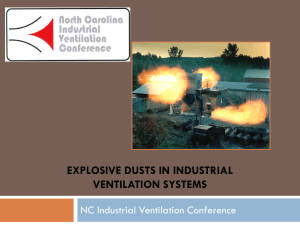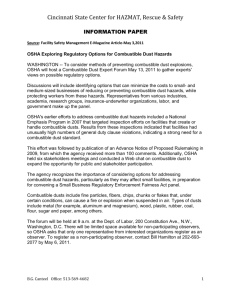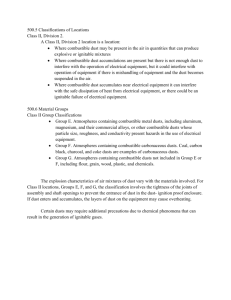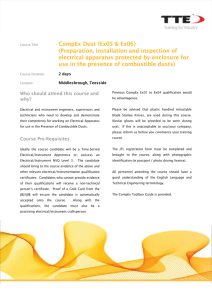Static-Hazards-final
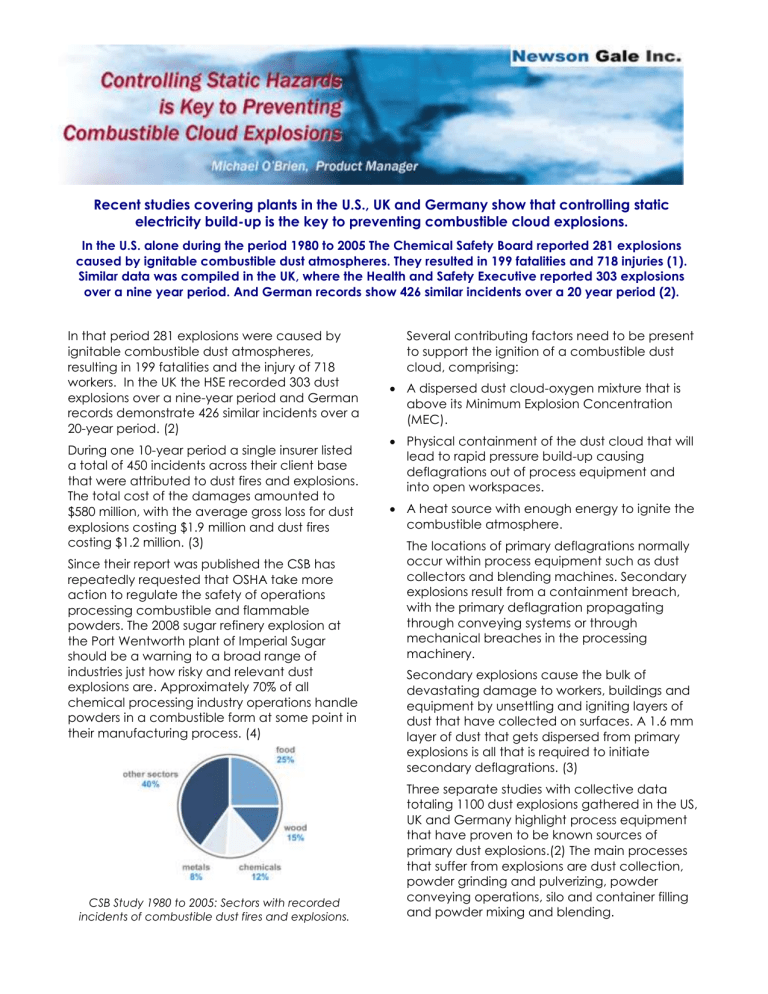
In that period 281 explosions were caused by ignitable combustible dust atmospheres, resulting in 199 fatalities and the injury of 718 workers. In the UK the HSE recorded 303 dust explosions over a nine-year period and German records demonstrate 426 similar incidents over a
20-year period. (2)
During one 10-year period a single insurer listed a total of 450 incidents across their client base that were attributed to dust fires and explosions.
The total cost of the damages amounted to
$580 million, with the average gross loss for dust explosions costing $1.9 million and dust fires costing $1.2 million. (3)
Since their report was published the CSB has repeatedly requested that OSHA take more action to regulate the safety of operations processing combustible and flammable powders. The 2008 sugar refinery explosion at the Port Wentworth plant of Imperial Sugar should be a warning to a broad range of industries just how risky and relevant dust explosions are. Approximately 70% of all chemical processing industry operations handle powders in a combustible form at some point in their manufacturing process. (4)
CSB Study 1980 to 2005: Sectors with recorded incidents of combustible dust fires and explosions.
Recent studies covering plants in the U.S., UK and Germany show that controlling static electricity build-up is the key to preventing combustible cloud explosions.
In the U.S. alone during the period 1980 to 2005 The Chemical Safety Board reported 281 explosions caused by ignitable combustible dust atmospheres. They resulted in 199 fatalities and 718 injuries (1).
Similar data was compiled in the UK, where the Health and Safety Executive reported 303 explosions over a nine year period. And German records show 426 similar incidents over a 20 year period (2).
Several contributing factors need to be present to support the ignition of a combustible dust cloud, comprising:
A dispersed dust cloud-oxygen mixture that is above its Minimum Explosion Concentration
(MEC).
Physical containment of the dust cloud that will lead to rapid pressure build-up causing deflagrations out of process equipment and into open workspaces.
A heat source with enough energy to ignite the combustible atmosphere.
The locations of primary deflagrations normally occur within process equipment such as dust collectors and blending machines. Secondary explosions result from a containment breach, with the primary deflagration propagating through conveying systems or through mechanical breaches in the processing machinery.
Secondary explosions cause the bulk of devastating damage to workers, buildings and equipment by unsettling and igniting layers of dust that have collected on surfaces. A 1.6 mm layer of dust that gets dispersed from primary explosions is all that is required to initiate secondary deflagrations. (3)
Three separate studies with collective data totaling 1100 dust explosions gathered in the US,
UK and Germany highlight process equipment that have proven to be known sources of primary dust explosions.(2) The main processes that suffer from explosions are dust collection, powder grinding and pulverizing, powder conveying operations, silo and container filling and powder mixing and blending.
German study: recorded sources of ignition in combustible dust explosions incidents.
The German data, which totaled 426 incidents, provides a percentage breakdown of known primary sources of ignition. In this study electrostatic discharges make up 10% of known primary ignition sources. The “unaccounted” category accounts for incidents where no physical evidence has been detected. The prime suspect in the “unaccounted” category is very often electrostatic discharges, but as no witnesses can provide evidence of seeing or hearing a spark, ignition sources of this type go unreported and unaccounted for.
Even though the majority of combustible dusts have higher MIE’s than flammable vapours the amount of energy available from electrostatic discharges within contained environments will ignite the vast majority of combustible dusts. This is because the rate of electrostatic charge generation and accumulation in powder processing operations is extremely high.
Incendive electrostatic sparks usually result from the lack of a thorough and detailed risk assessment, unintended changes to equipment during routine maintenance and unsafe operator working practices.
Therefore, to prevent electrostatic discharges igniting combustible dust atmospheres companies should risk assess their processes and equipment to ensure any potential sources of ignition are identified and managed correctly.
Incendive electrostatic sparks usually result from
2 the lack of a thorough and detailed risk assessment, unintended changes to equipment during routine maintenance and unsafe operator working practices. All potential sources of internal and external static discharges from process equipment situated in zoned & classified areas must be accounted for and managed in the appropriate way.
Isolated components in conveying and dust
collection systems are capable of storing large amounts of static charges if they are not sufficiently earthed. Isolated components usually result from design oversight or after maintenance teams reassemble fittings without re-establishing static bonding connections.
Pipes, valves, blowers, hoppers and other components engaged in powder transfer processes can be isolated from each other due the insulating properties of parts like rubber gaskets or through normal wear and tear. The most secure means of preventing charge buildup is to bond and ground components to a reliable high integrity ground point. The NFPA (5) and CENELEC (6)state these bonding connections should have a resistance to earth of less than 10 ohms.
To manage the uncertainty of knowing whether or not components can become isolated during processing operations, dedicated static grounding equipment can be specified to monitor all potentially isolated points in the conveying system. If a component loses its connection to ground, or experiences a rise above 10 ohms resistance in the bonding circuit, operators can be alerted to the potential hazard immediately, either through automatic shut-down of the operation or by hazard strobes and alarms.
The same kind of device can be used to ground and bond components in systems such as fluid bed dryers which experience vibration effects that can lead to momentary sparks gaps between components that make up the overall assembly. Isolated charged components have the capability to discharge to fully bonded or grounded components within the structure of the machine. The important thing to do is fully assess the potential of components to become momentarily isolated as static sparks can release large amounts of energy in milliseconds.
Charges accumulating on the surface of mixing
and blending machines can be dissipated using discrete purpose designed earthing systems.
These systems provide dual protection dissipating static from the vessel wall preventing internal discharges into the potentially combustible atmosphere present in the vessel and preventing external discharges into the potentially flammable or combustible atmosphere surrounding the machine.
Continuous monitoring of the grounding circuit combined with output contacts, that can be deployed to shut down the process or alert personnel to the hazard, maximizes the safety of the process and workers in vicinity of the machine.
Powder filling operations often produce clouds
of combustible dusts that have the potential to disperse in oxygen above their MEC limit. Spark discharges and Propagating Brush Discharges
(PBDs) can ignite the resulting dust cloud. It is critical to ensure that conductive and semiconductive powders are not deposited into containers or bags that insulate the resulting charges. Type C FIBC bags can mitigate against these risks by conducting charge from the powder through conductive threads in the bag to the earth connection point on the bag. As charges are dissipated from the surface of the powder the risk of static spark discharges to nearby conductive objects and uncontrolled
PBDs over the powder surface is reduced.
To compensate for normal wear and tear on bags it is important to ensure the bag maintains its capacity to dissipate charge and also ensure the earth connection between the bag and known grounding point is functioning correctly.
Dedicated grounding systems can be specified that ensure the resistance of the bag is compliant with the requirements of the
CENELEC (6) standard. Should the bag lose its ground connection, the system will draw the attention of operators to this potential hazard.
Vacuum truck operations are particularly
vulnerable to incendive static spark discharges.
The movement of charged powder from source to collection chamber can induce large charges on lances, hose connections, the hose itself and components within the collecting chamber. A range of deflagration incidents have been reported in vacuum truck operations, particularly in situations where components on hoses and lances have become isolated and discharged static sparks into the surrounding atmosphere or within the vacuuming system. The American Petroleum
Institute (7) recommends that all connecting
3 metal parts of the vacuum collection system are conductive to less than 10 ohms and that the vacuum truck itself is connected to a fully verified ground point.
Truck-mounted bonding systems, containing flashing LEDs can be specified helping operators observe 10 ohm, or less, connections to pre-installed grounding points. Another system, currently in development, will enable operators to confirm a full ground connection using a truck-mounted mobile ground proving system. This groundbreaking system will eliminate the time and uncertainty of using meters to measure and establish safe ground connections in locations where pre-installed grounding points do not exist.
What to do: To prevent uncontrolled electrostatic discharges posing a fire and explosion hazard in powder processing operations, a thorough static audit should be conducted by qualified personnel.
The audit should focus on investigating and identifying situations where charge has the potential to accumulate on conductive and semi-conductive components. For situations where potentially isolated components are identified dedicated grounding equipment should be installed to monitor and control the release of static electricity, thereby removing a primary source of ignition in combustible dust atmospheres.
(1) Report No. 2006-H-1 “Combustible Dust Hazard
Study”, Chemical Safety Board (2006).
(2) “Dust Explosion Scenarios and Case Histories in the CCPS Guidelines for Safe Handling of Powders and Bulk Solids”, Grossel, S.S., Zalosh, R.G., Center for Chemical Process Safety, (2005).
(3) “Recipe for a Dust Explosion”, Tranquillo, S., www.hazardexonthenet.net, (2008).
(4) “Preventing Dust Explosions”, Shelley, S., CEP magazine article, (2008).
(5) NFPA77: “Recommended Practice on Static
Electricity”, NFPA (2007).
(6) CLC/TR 50404: “Electrostatics. Code of practice for the avoidance of hazards due to static electricity”, CENELEC (2003).
(7) API RP 2003: “Protection Against Ignitions
Arising out of Static, Lightning, and Stray Currents”,
American Petroleum Institute (2008).
